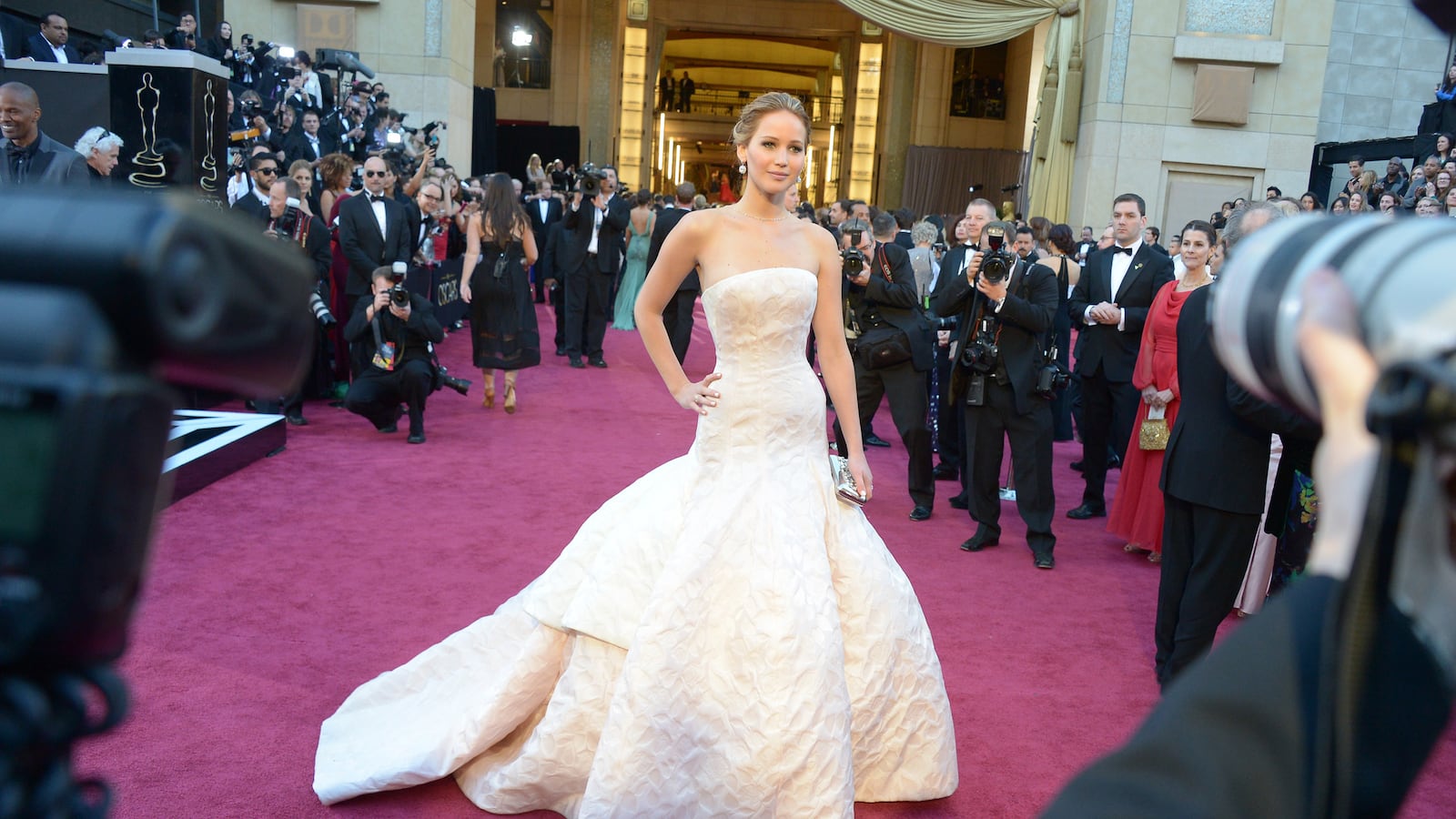
It might seem strange to people watching the red carpet for the procession of famous-name designer gowns on Sunday night that prior to the mid-to-late nineties, actors and actresses attended the Academy Awards in pieces crafted by some of Hollywood’s greatest costume designers. Back then, the red carpet wasn't the province of Prada, Valentino, and Christian Dior. Instead, great movie dress designers including Helen Rose and Edith Head costumed the likes of Grace Kelly, Elizabeth Taylor, and Audrey Hepburn in one-of-a-kind pieces specifically crafted to fit their measurements, personality, and film role.
But Barbara Tfank (her surname pronounced tee-fank) arguably changed all that when she dressed a young Uma Thurman for the 1995 Academy Awards—where she received a Best Supporting Actress nomination for her role in Pulp Fiction—in a lavender, custom-made Prada gown. The moment was an Oscar’s night game-changer, propelling high-end designers to vie for dressing Hollywood’s biggest stars.
The dress is a classic, with its soft, lavender hue, chiffon fabric, and minimalist shape. To have Thurman, a young, promising actress wearing a gown by a label that, at the time, had never made an evening gown and was barely recognized in the United States—and if so, it was for its nylon accessories—was a pivotal movement in the now-symbiotic relationship between fashion and film.
Since Thurman’s Prada gown, the roster of designer Oscars dresses has become a memorable hit parade. At the 1998 Academy Awards, Sharon Stone chose to pair a sleek lavender Vera Wang skirt with a white button-down. Pulled from her husband’s closet. Purchased from The Gap. The following year Gwyneth Paltrow, who won the Academy Award for Best Actress for Shakespeare in Love, wore a pink princess dress by Ralph Lauren, which became an instant classic. Halle Berry won the same award in 2002 for Monster's Ball when she dazzled in a semi-sheer, maroon Elie Saab gown. The public love-in with Jennifer Lawrence was sealed with her daring, red slinky Calvin Klein number at the 2011 Oscars.
Yet surprisingly, the woman who originated this annual cavalcade now dismisses the spectacle she seemingly created. “I say to people, “Name me a memorable dress,” and they say, 'Oh, Gwyneth Paltrow wore Tom Ford,'” Tfank, now a New York-based fashion designer, told The Daily Beast. “And I agree, the dress was memorable. But there are a lot of things people in fashion don’t do that Helen Rose or Edith Head would have done. I feel like, in a way, it’s lost a little bit of its creativity. I’m not saying they aren’t beautiful dresses—there are incredible dresses and people are working extremely hard to merge fashion and film. Sometimes I wonder, however, if the dress really reflects the actor and their body. People look so uncomfortable. They don’t look like they inhabit the clothes. Oftentimes it looks as though they are borrowed. That part of it saddens me. I think, sometimes, people are forgetting about the performance.”
Tfank herself had an intriguing journey to the red carpet. She grew up in New York City, a fan of old Hollywood glamor and fashion, which eventually led to her professional career. Trained as a designer in the eighties, she began doing styling work with photographers like Richard Avedon, when the design company she was working for in New York closed. With some styling under her belt, Tfank used her experience to build a career as a costume designer. She moved to LA and began working on films including the 1992 drama, A Midnight Clear, starring Ethan Hawke, and the 1993 Nicholas Kazan movie Dream Lover featuring James Spader and Mädchen Amick, which began her relationship with Prada.
“There I was in L.A. doing this movie and Miuccia [Prada] lent me all these clothes,” Tfank said. “When the movie was over, Prada asked me, ‘Can you help us get someone dressed for the Oscars?’ I said, ‘I’ve never done it before, but I could try to help you.' So I officially started working as a consultant for them. I ended up doing sketches—I did four different renderings—and I sent them out to various actors. Uma Thurman wanted to wear Prada, and that’s how it happened.”
The dress ended up on the cover of Women’s Wear Daily and seemingly started the trend of actors and actresses sporting designer pieces on the red carpet. Stylist Sasha Charnin Morrison, author of Secrets of Stylists: An Insider’s Guide to Styling the Stars, has said that celebrity styling really didn’t exist before Tfank placed Thurman in the Prada number. “It wasn’t a costume design by Helen Rose, it wasn’t a Bob Mackie creation, it just wasn’t a costume,” Charnin said. “It was a piece that someone could buy off a rail. Before then, you didn’t know where red carpet gowns came from.”
Tfank, Thurman, and Prada were the trifecta that changed everything in 1995—even if it was accidental. “What was really great about it was that it was so not planned,” Tfank said. “It was so organic. And what was really amazing was that it was a dress made for her. It wasn’t runway look number 25. It was her dress. No one knew that it was going to be this sort-of ground-breaking, pioneering into celebrity dressing.”
Today, Tfank cannot believe how significant her own big Oscars moment became—she sees at simply just doing her job. “When I look back on it now, I think the reason it worked and is still revered and appearing in books and all sorts of things is because it was very appropriate for her at her age,” the designer said. “It was very photogenic. It fit her. The shawl—no one had ever worn a shawl like that before. We embroidered it with opalescent sequins and it really created almost a giant chrysalis, so when she took it off she became the butterfly. There was a certain amount of costume design drama in it, which, if you look back at the Oscars, you always see people like Grace Kelly or Audrey Hepburn arriving in evening coats, holding them tight with their white gloves and you think, ‘Oh my god, what’s it going to look like when they take their coat off?!’ Then you see pictures of them sitting and there’s this amazing diamond necklace or beautiful décolleté. I was employing that sort of magic of Hollywood, of drama.”
Unfortunately, Tfank thinks, the old Hollywood glamour has diminished as commercial designers stake their claims on the red carpet. The fascination has transformed celebrity dressing into a business, rather than a form of artistic expression. “Back then,” she explained, “it was really about an artistic pursuit and designing a beautiful dress. And now it’s brokering this and brokering that, and buying this person and buying that person.”
Tfank cites Douglas Sirk’s ‘women’s films’ of the thirties, forties, fifties, sixties as a time “women went to the cinema to be inspired and to sort of fulfill their fantasies” through the clothing and the stories. Film was an outlet, and the intricately crafted pieces—regardless of who made them—told their own stories. “Now that films are not really catering to women, where do women find that place where they can fantasize and live vicariously through?” Tfank asks.
Even during the Depression and World War Two, she said, "you had these fantasy worlds happening in cinema which really fed the spirit of people. If you look through old Vogue magazines, you find how people worked on decorating their hats with feathers and trimmings because there was no silk fabric for dresses. There was this kind-of need that people had.”
Although Tfank is credited with putting Prada on the red carpet, the way she did it, she explains, was based around the idea of performance, similar to that of the Old Hollywood costume designers. Each actress sported a look individual to who they were—“It’s not about how thin [the actress] is or how she did her hair,” she said. “People are starting to look like each other. You don’t have Rita Hayworth, Elizabeth Taylor, Marilyn Monroe, or Grace Kelly. How could you confuse them? How could you say ‘Who’s that?’ You knew who that was. The Hollywood 'beauty factory' was pretty amazing. They knew how to create beauty, an identity, an icon. Everybody’s looking a bit ‘Stepford Wife’ these days. I wish it was personality was showing through.”
There are still gorgeous gowns being produced, Tfank insists, but the individuality seems to have diminished. The creative outlet has seemed to turn into a marketing frenzy. Outfits have become so intricately planned—and more times than not, without considering the actress and her role.
Tfank, however, has never abandoned the idea of costuming. In 2001, she went back to her roots, establishing her eponymous label of brocade dresses and evening coats that focus on sharp tailoring and femininity. Her craftsmanship has become a favorite of Michelle Obama—whom she dressed for the First Lady’s 2011 trip to meet Queen Elizabeth, as well as the 2012 State of the Union address—and Adele. And while Tfank’s passion has always been for design, her pivotal moment of bringing celebrity dressing to Hollywood will always be something she both cherishes and questions.
“What does fashion really do for people?” Tfank asks. “What is the real meaning of it? You look back and see that people have been decorating themselves for centuries and it often had to do with one’s rank, wealth, and position—but now it’s based on how popular you are or how much press that you get. It will be interesting in a hundred years to see what they think of reality TV and what people are like on the red carpet. But everybody needs their goddesses. Everyone wants to worship something outside of themselves. I think it’s a real human need—I just wish that it was a little less political and contrived.”
“There’s always been kind of a love affair between fashion and film,” Tfank said. “But now it feels like, what are the intentions of it? Who does it really benefit?”






